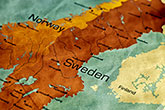The sulfur circle of life
Published by Oliver Kleinschmidt,
Deputy Editor
World Fertilizer,
Jan Hermans, Sulphurnet, the Netherlands, discusses the essential role that sulfur plays in the health of plants and its use in fertilizers.
Sulfur is an essential element for life, playing a fundamental role in the health of both plants and animals. It is a key component of amino acids, which are the building blocks of proteins, as well as vitamins and enzymes necessary for biological functions. Plants absorb sulfur from the soil in its dissolved form, integrating it into their tissues. Animals, in turn, acquire the sulfur they need by consuming these plants, ensuring proper metabolism, enzyme activity, and overall well-being. This continuous cycle of sulfur transfer highlights its importance in sustaining life and maintaining ecological balance across various ecosystems.
The movement and transformation of sulfur through different Earth systems are scientifically known as the ‘sulfur cycle’. This natural biochemical process demonstrates how sulfur transitions between various reservoirs, including the atmosphere, hydrosphere, lithosphere, and biosphere. It is crucial in recycling sulfur, ensuring its continuous availability for living organisms. Plants absorb sulfur from the soil, incorporating it into essential compounds, which are then passed on to animals through consumption. Beyond its biological significance, the sulfur cycle plays a vital role in maintaining ecological balance. It regulates nutrient distribution, influences soil fertility, and even impacts climate and weather patterns. Understanding this cycle is essential for studying environmental sustainability and the broader interactions between Earth’s natural systems.
Sulfur compounds, especially sulfur-dioxide (SO2) and sulfate aerosols, contribute to cloud formation and atmospheric chemistry, which can affect global temperatures and precipitation patterns. Sulfur also helps with the regulation of the pH of soil and water, which is critical for ecosystem health.
The main stages of the sulfur cycle
The main stages of the sulfur cycle are displayed in Figure 1 and outlined as follows:
Atmospheric sulfur
Sulfur exists in the air as SO2, which comes from volcanic eruptions, burning fossil fuels, and decaying organic matter. This gas can combine with water to form sulfuric acid, leading to acid rain.
Deposition and absorption
Sulfur in the atmosphere eventually falls to the Earth as precipitation or settles as dust. Plants absorb sulfur from the soil in the form of sulfate (SO42-), which they use to grow.
Consumption and decomposition
Animals obtain sulfur by consuming plants or other animals. When organisms die, decomposers like bacteria and fungi break down their remains, releasing sulfur back into the environment.
Microbial activity
Special bacteria, known as sulfur-reducing bacteria, convert sulfur compounds into hydrogen sulfide (H2S)/other bacteria then convert H2S back into sulfate, continuing the cycle.
Human impact on the sulfur cycle
Human activities have significantly altered the natural sulfur cycle, primarily through the burning of fossil fuels, industrial emissions, and large scale mining. These processes release excessive amounts of SO2 into the atmosphere, leading to environmental issues such as acid rain, soil acidification, and oceanic sulfur imbalances. The disruption reduces sulfur storage in rocks and affects its natural availability for biological processes, impacting plant and animal health.
In response to these challenges, stricter environmental regulations in Western Europe, North America, and increasingly in developing nations have successfully reduced atmospheric sulfur deposition. However, this reduction has led to unintended consequences, such as sulfur deficiencies in agricultural soils, which can hinder crop growth and productivity. Balancing sulfur management is crucial to maintaining both environmental health and agricultural sustainability.
Download your own copy of World Fertilizer and read the full article and more like it here.
Read the article online at: https://www.worldfertilizer.com/special-reports/29072025/the-sulfur-circle-of-life/
You might also like
Cinis Fertilizer reveals plans for fertilizer plant overhaul
Cinis Fertilizer has announced its plans for an overhaul of its plant and will temporarily suspend fertilizer production.

